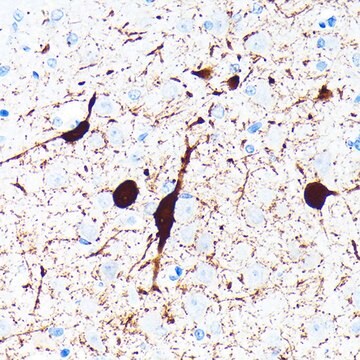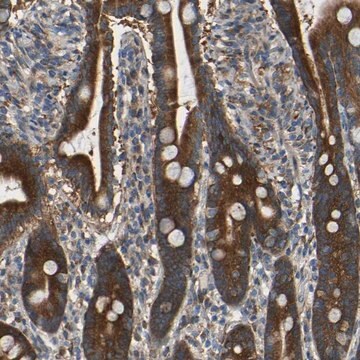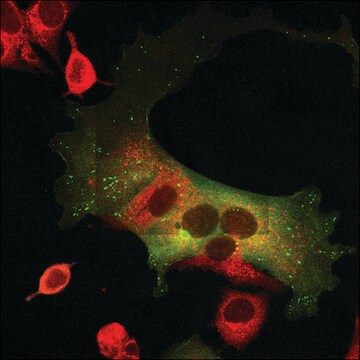おすすめの製品
由来生物
rabbit
品質水準
抗体製品の状態
serum
抗体製品タイプ
primary antibodies
クローン
polyclonal
化学種の反応性
human, rat, sheep, chicken, mouse, bovine
メーカー/製品名
Chemicon®
テクニック
ELISA: suitable
immunohistochemistry: suitable
western blot: suitable
NCBIアクセッション番号
UniProtアクセッション番号
輸送温度
wet ice
ターゲットの翻訳後修飾
unmodified
遺伝子情報
human ... YWHAG(7532)
詳細
Mammals express seven distinct 14-3-3 isoforms (gamma, epsilon, beta, zeta, sigma, theta, tau) that form multiple homo- and hetero- dimmers, thus rendering 14-3-3 as a key multifunctional regulatory molecule. 14-3-3 isomers have been implicated in several neurological disorders: for example isoforms gamma, epsilon and beta are expressed in the cerebrospinal fluid of Creutzfeldt-Jakob patients, but not patients suffering from other neurological conditions such as Alzheimer′s.
The 14-3-3 gamma antibody is one of a panel of antibodies that were generated against 14-3-3 isoforms and have demonstrated their potential for use as an ELISA-based diagnostic tool. These antibodies will allow the research to investigate the role of this protein in key cellular processes and neurological disorders such as Creutzfeldt-Jakob, Alzheimer′s and Parkinson′s Disease.
The 14-3-3 gamma antibody is one of a panel of antibodies that were generated against 14-3-3 isoforms and have demonstrated their potential for use as an ELISA-based diagnostic tool. These antibodies will allow the research to investigate the role of this protein in key cellular processes and neurological disorders such as Creutzfeldt-Jakob, Alzheimer′s and Parkinson′s Disease.
特異性
14-3-3 gamma. By Western blot the antibody recognizes the ~30 kDa protein.
免疫原
Synthetic peptide from the N-terminal area of sheep 14-3-3 gamma.
アプリケーション
Anti-14-3-3 γ Antibody detects level of 14-3-3 γ & has been published & validated for use in ELISA, WB, IH.
Western blot: 1:6,000-1:12,000 using ECL.
Immunohistochemistry: 1:400-1:800 on mouse brain tissue which was treated by hydrated autoclaving at 121°C for 15 minutes prior to immunolabeling. Endogenous peroxidase was blocked with hydrogen peroxide in methanol and non-specific labeling with normal goat serum at 1:20 for 5 minutes.
ELISA
Optimal working dilutions must be determined by end user.
Immunohistochemistry: 1:400-1:800 on mouse brain tissue which was treated by hydrated autoclaving at 121°C for 15 minutes prior to immunolabeling. Endogenous peroxidase was blocked with hydrogen peroxide in methanol and non-specific labeling with normal goat serum at 1:20 for 5 minutes.
ELISA
Optimal working dilutions must be determined by end user.
法的情報
CHEMICON is a registered trademark of Merck KGaA, Darmstadt, Germany
適切な製品が見つかりませんか。
製品選択ツール.をお試しください
保管分類コード
10 - Combustible liquids
試験成績書(COA)
製品のロット番号・バッチ番号を入力して、試験成績書(COA) を検索できます。ロット番号・バッチ番号は、製品ラベルに「Lot」または「Batch」に続いて記載されています。
H Martin et al.
FEBS letters, 331(3), 296-303 (1993-10-04)
14-3-3 proteins are apparently ubiquitous eukaryotic proteins that comprise a large number of isoforms. They have been implicated in the regulation of a wide range of biological processes [reviewed in Aitken et al. (1992) Trends Biochem. Sci. 17, 498-501]. We
J Wiltfang et al.
Journal of neurochemistry, 73(6), 2485-2490 (1999-12-03)
Two-dimensional polyacrylamide gel electrophoresis of CSF has been used in the diagnosis of Creutzfeldt-Jakob disease (CJD). One of the two diagnostic protein spots was identified as isoform(s) of the 14-3-3 family of abundant brain proteins. This has led to the
Maliha Chaudhri et al.
Biochemical and biophysical research communications, 300(3), 679-685 (2003-01-01)
The 14-3-3 protein family associates with many proteins involved in intracellular signalling. In many cases, there is a distinct preference for a particular isoform(s) of 14-3-3. A specific repertoire of 14-3-3 dimer formation may therefore influence which of the interacting
Petra Steinacker et al.
Molecular and cellular biology, 25(4), 1339-1346 (2005-02-03)
The diagnosis of sporadic Creutzfeldt-Jakob disease (CJD) is based on typical clinical findings and is supported by a positive 14-3-3 Western blot of cerebrospinal fluid. However, it is not clear whether 14-3-3 indicates general neuronal damage or is of pathophysiological
Hung-Kai Chen et al.
Cell, 113(4), 457-468 (2003-05-22)
Spinocerebellar ataxia type 1 (SCA1) is one of several neurological disorders caused by a CAG repeat expansion. In SCA1, this expansion produces an abnormally long polyglutamine tract in the protein ataxin-1. Mutant polyglutamine proteins accumulate in neurons, inducing neurodegeneration, but
ライフサイエンス、有機合成、材料科学、クロマトグラフィー、分析など、あらゆる分野の研究に経験のあるメンバーがおります。.
製品に関するお問い合わせはこちら(テクニカルサービス)







